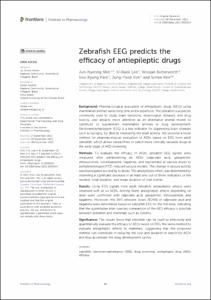Zebrafish EEG predicts the efficacy of antiepileptic drugs
- Title
- Zebrafish EEG predicts the efficacy of antiepileptic drugs
- Author(s)
- Shin, Jun-Nyeong ; Lee, Ki-Baek ; Butterworth, Woojae ; Park, Soo-Kyung ; Kim, Jung-Yeon ; Kim, Sohee
- Issued Date
- 2022-12
- Citation
- Frontiers in Pharmacology, v.13
- Type
- Article
- Author Keywords
- zebrafish ; electroencephalogram (EEG) ; drug screening ; antiepileptic drug (AED) ; efficacy
- Keywords
- HIGH-FREQUENCY OSCILLATIONS ; PENTYLENETETRAZOLE ; EPILEPSY ; BIOMARKER ; MODELS
- ISSN
- 1663-9812
- Abstract
- Background: Pharmacological evaluation of antiepileptic drugs (AEDs) using mammalian animals takes long time and is expensive. The zebrafish is a species commonly used to study brain functions, neurological diseases, and drug toxicity, and attracts more attention as an alternative animal model to substitute or supplement mammalian animals in drug development. Electroencephalogram (EEG) is a key indicator for diagnosing brain diseases such as epilepsy, by directly measuring the brain activity. We propose a novel method for pharmacological evaluation of AEDs based on EEG from adult zebrafish, which allows researchers to select more clinically valuable drugs at the early stage of AED screening. Methods: To evaluate the efficacy of AEDs, zebrafish EEG signals were measured after administering six AEDs (valproate acid, gabapentin, ethosuximide, oxcarbazepine, tiagabine, and topiramate) at various doses to pentylenetetrazol (PTZ)-induced seizure models. The change in seizure activity was investigated according to doses. The antiepileptic effect was determined by observing a significant decrease in at least one out of three indicators of the number, total duration, and mean duration of ictal events. Results: Using EEG signals from adult zebrafish, antiepileptic effects were observed with all six AEDs. Among them, antiepileptic effects depending on dose were confirmed with valproate acid, gabapentin, ethosuximide, and tiagabine. Moreover, the 50% effective doses (ED50) of valproate acid and tiagabine were determined based on zebrafish EEG for the first time, indicating that the quantitative inter-species comparison of the AED efficacy is possible between zebrafish and mammals such as rodents. Significance: The results show that zebrafish can be used to effectively and quantitatively evaluate the efficacy of AEDs based on EEG, the same method to evaluate antiepileptic effects in mammals, suggesting that the proposed method can contribute in reducing the cost and duration of search for AEDs and thus accelerate the drug development cycles. Copyright © 2022 Shin, Lee, Butterworth, Park, Kim and Kim.
- Publisher
- Frontiers Media S.A.
- Related Researcher
-
-
Kim, Sohee
- Research Interests Neural interface; Brain interface; Bio MEMS; Soft MEMS; Stretchable electronics; Zebrafish electrophysiology
-
- Files in This Item:
-
 기타 데이터 / 1.82 MB / Adobe PDF
download
기타 데이터 / 1.82 MB / Adobe PDF
download
- Appears in Collections:
- ETC 1. Journal Articles



